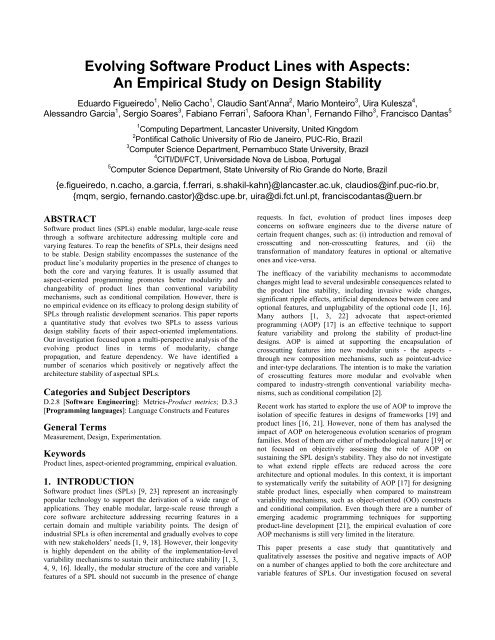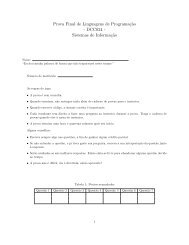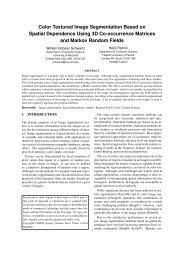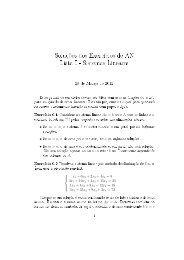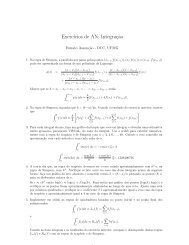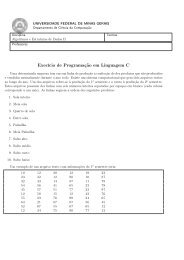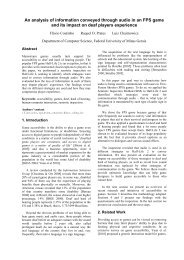Evolving Software Product Lines with Aspects: An Empirical ... - UFMG
Evolving Software Product Lines with Aspects: An Empirical ... - UFMG
Evolving Software Product Lines with Aspects: An Empirical ... - UFMG
You also want an ePaper? Increase the reach of your titles
YUMPU automatically turns print PDFs into web optimized ePapers that Google loves.
<strong>Evolving</strong> <strong>Software</strong> <strong>Product</strong> <strong>Lines</strong> <strong>with</strong> <strong>Aspects</strong>:<br />
<strong>An</strong> <strong>Empirical</strong> Study on Design Stability<br />
Eduardo Figueiredo 1 , Nelio Cacho 1 , Claudio Sant’<strong>An</strong>na 2 , Mario Monteiro 3 , Uira Kulesza 4 ,<br />
Alessandro Garcia 1 , Sergio Soares 3 , Fabiano Ferrari 1 , Safoora Khan 1 , Fernando Filho 3 , Francisco Dantas 5<br />
1 Computing Department, Lancaster University, United Kingdom<br />
2 Pontifical Catholic University of Rio de Janeiro, PUC-Rio, Brazil<br />
3 Computer Science Department, Pernambuco State University, Brazil<br />
4 CITI/DI/FCT, Universidade Nova de Lisboa, Portugal<br />
5 Computer Science Department, State University of Rio Grande do Norte, Brazil<br />
{e.figueiredo, n.cacho, a.garcia, f.ferrari, s.shakil-kahn}@lancaster.ac.uk, claudios@inf.puc-rio.br,<br />
{mqm, sergio, fernando.castor}@dsc.upe.br, uira@di.fct.unl.pt, franciscodantas@uern.br<br />
ABSTRACT<br />
<strong>Software</strong> product lines (SPLs) enable modular, large-scale reuse<br />
through a software architecture addressing multiple core and<br />
varying features. To reap the benefits of SPLs, their designs need<br />
to be stable. Design stability encompasses the sustenance of the<br />
product line’s modularity properties in the presence of changes to<br />
both the core and varying features. It is usually assumed that<br />
aspect-oriented programming promotes better modularity and<br />
changeability of product lines than conventional variability<br />
mechanisms, such as conditional compilation. However, there is<br />
no empirical evidence on its efficacy to prolong design stability of<br />
SPLs through realistic development scenarios. This paper reports<br />
a quantitative study that evolves two SPLs to assess various<br />
design stability facets of their aspect-oriented implementations.<br />
Our investigation focused upon a multi-perspective analysis of the<br />
evolving product lines in terms of modularity, change<br />
propagation, and feature dependency. We have identified a<br />
number of scenarios which positively or negatively affect the<br />
architecture stability of aspectual SPLs.<br />
Categories and Subject Descriptors<br />
D.2.8 [<strong>Software</strong> Engineering]: Metrics-<strong>Product</strong> metrics; D.3.3<br />
[Programming languages]: Language Constructs and Features<br />
General Terms<br />
Measurement, Design, Experimentation.<br />
Keywords<br />
<strong>Product</strong> lines, aspect-oriented programming, empirical evaluation.<br />
1. INTRODUCTION<br />
<strong>Software</strong> product lines (SPLs) [9, 23] represent an increasingly<br />
popular technology to support the derivation of a wide range of<br />
applications. They enable modular, large-scale reuse through a<br />
core software architecture addressing recurring features in a<br />
certain domain and multiple variability points. The design of<br />
industrial SPLs is often incremental and gradually evolves to cope<br />
<strong>with</strong> new stakeholders’ needs [1, 9, 18]. However, their longevity<br />
is highly dependent on the ability of the implementation-level<br />
variability mechanisms to sustain their architecture stability [1, 3,<br />
4, 9, 16]. Ideally, the modular structure of the core and variable<br />
features of a SPL should not succumb in the presence of change<br />
requests. In fact, evolution of product lines imposes deep<br />
concerns on software engineers due to the diverse nature of<br />
certain frequent changes, such as: (i) introduction and removal of<br />
crosscutting and non-crosscutting features, and (ii) the<br />
transformation of mandatory features in optional or alternative<br />
ones and vice-versa.<br />
The inefficacy of the variability mechanisms to accommodate<br />
changes might lead to several undesirable consequences related to<br />
the product line stability, including invasive wide changes,<br />
significant ripple effects, artificial dependences between core and<br />
optional features, and unplugability of the optional code [1, 16].<br />
Many authors [1, 3, 22] advocate that aspect-oriented<br />
programming (AOP) [17] is an effective technique to support<br />
feature variability and prolong the stability of product-line<br />
designs. AOP is aimed at supporting the encapsulation of<br />
crosscutting features into new modular units - the aspects -<br />
through new composition mechanisms, such as pointcut-advice<br />
and inter-type declarations. The intention is to make the variation<br />
of crosscutting features more modular and evolvable when<br />
compared to industry-strength conventional variability mechanisms,<br />
such as conditional compilation [2].<br />
Recent work has started to explore the use of AOP to improve the<br />
isolation of specific features in designs of frameworks [19] and<br />
product lines [16, 21]. However, none of them has analysed the<br />
impact of AOP on heterogeneous evolution scenarios of program<br />
families. Most of them are either of methodological nature [19] or<br />
not focused on objectively assessing the role of AOP on<br />
sustaining the SPL design's stability. They also do not investigate<br />
to what extend ripple effects are reduced across the core<br />
architecture and optional modules. In this context, it is important<br />
to systematically verify the suitability of AOP [17] for designing<br />
stable product lines, especially when compared to mainstream<br />
variability mechanisms, such as object-oriented (OO) constructs<br />
and conditional compilation. Even though there are a number of<br />
emerging academic programming techniques for supporting<br />
product-line development [21], the empirical evaluation of core<br />
AOP mechanisms is still very limited in the literature.<br />
This paper presents a case study that quantitatively and<br />
qualitatively assesses the positive and negative impacts of AOP<br />
on a number of changes applied to both the core architecture and<br />
variable features of SPLs. Our investigation focused on several
evolution scenarios of two heterogeneous product lines (Section<br />
3), called MobileMedia [29, 30] and BestLap [2], which were<br />
both implemented in Java and AspectJ. Conditional compilation<br />
was the variability mechanism used in the Java releases, which<br />
were used in turn <strong>with</strong> the goal of supporting an analysis of AOP.<br />
In other words, the goal of our comparative analysis was to<br />
observe to what extent AOP mechanisms provide or not enhanced<br />
product line stability in the presence of change tasks. The design<br />
stability evaluation of the Java and AspectJ versions were based<br />
on three conventional metrics suites for change impact [28]<br />
(Section 4), modularity [25] (Section 5), and feature dependency<br />
[15] (Section 6). We documented scenarios where AOP succeeds<br />
or not. For example, AOP copes well <strong>with</strong> the separation of<br />
features <strong>with</strong> no shared code. Furthermore, when adding an<br />
optional or alternative feature, AspectJ adheres better than Java to<br />
well-known design principles, such as the Open-Closed principle<br />
[20]. However, AOP is particularly vulnerable to changes<br />
targeting core features. For example, turning a mandatory feature<br />
into alternatives leads to ripple effects across the SPL design.<br />
2. STUDY SETTING<br />
This section describes the configuration of our study. Section 2.1<br />
briefly explains the two variability techniques evaluated in this<br />
study. Section 2.2 describes the evaluation methodology.<br />
2.1 Variability Programming Mechanisms<br />
In order to enable the variation of software product lines (SPLs),<br />
this work considers two variability implementation techniques:<br />
AOP [17] and conditional compilation. We chose AspectJ [27] to<br />
implement variability <strong>with</strong> AOP because it is the most<br />
consolidated AOP language. Besides, our goal was to assess the<br />
suitability of core AOP mechanisms for handling variability<br />
rather than other emerging AOP mechanisms available in<br />
programming languages, such as CaesarJ [21]. Conditional<br />
compilation, on the other hand, is a well-known technique for<br />
handling variation [2]. Basically, preprocessor directives indicate<br />
pieces of code that should compile or not based on the value of<br />
preprocessor variables. Such decision may be at the level of a<br />
single line of code or to a whole file. For instance, Figure 1<br />
describes a slice of code of the MobileMedia application where a<br />
logical connector is used to determine when the enclosed code of<br />
two features (smsFeature and captureMedia) must be compiled.<br />
01 //#ifdef copyMedia<br />
02 private void processMediaData(String mediaName,<br />
String albumName) {<br />
03 MediaData mediaData = null;<br />
04 //#if smsFeature || captureMedia<br />
05 byte[] mediaByte = getCapturedMedia();<br />
06 if (mediaByte == null)<br />
07 //#endif<br />
08 mediaData = getAlbumData().getMediaInfo(mediaName);<br />
09 //#if smsFeature || captureMedia<br />
10 if (mediaByte != null)<br />
11 getAlbumData().<br />
addMediaData(mediaName, mediaByte, albumName);<br />
12 else<br />
13 //#endif<br />
14 getAlbumData().addMediaData(mediaData, albumName);<br />
15 }<br />
16 //#endif<br />
Figure 1. Variability <strong>with</strong> conditional compilation<br />
Alternatively, AOP languages support the modular definition of<br />
features which are generally spread throughout the system and<br />
tangled <strong>with</strong> core features [1, 4, 16]. For instance, the pieces of<br />
code enclosed by #if and #endif in Figure 1 belong to optional<br />
features and AOP separates them using pointcuts, advices or<br />
inter-type declarations. Figure 2 shows a possible implementation<br />
of the variability points of Figure 1 using AspectJ mechanisms.<br />
The tangled code common to the smsFeature and captureMedia<br />
features is now modularised in a unique place (around advice).<br />
01 public aspect SMSOrCaptureMedia {<br />
02 pointcut processMediaData (...): execution(*<br />
*.processMediaData(...)) && this(...) && args(...);<br />
03 void around (...): processMediaData(...) {<br />
04 byte[] mediaByte = controller.getCapturedMedia();<br />
05 if (mediaByte == null)<br />
06 proceed(controller, mediaName, albumName);<br />
07 else<br />
08 controller.getAlbumData().<br />
addMediaData(mediaName, mediaByte, albumName);<br />
09 }<br />
10 }<br />
Figure 2. Variability <strong>with</strong> AOP mechanisms<br />
2.2 Study Phases and Assessment Procedures<br />
The study was divided into three major phases: (1) the design and<br />
realisation of SPL change scenarios, (2) the alignment of SPL<br />
versions, and (3) the quantitative and qualitative assessments of<br />
the SPL versions and successive releases. In the first phase, an<br />
independent group of five post-graduate students was responsible<br />
for implementing the successive evolution scenarios of two SPLs:<br />
BestLap [2] and MobileMedia [29, 30] (Section 3). The original<br />
releases of both product lines used in this study were available in<br />
both AspectJ and Java (the Java versions use conditional<br />
compilation as the variability mechanism). Then, each new<br />
release was created by modifying the previous release of the<br />
respective SPL. For example, AspectJ release 2 evolved from<br />
AspectJ release 1. Best-of-breed design practices [5, 9] were<br />
applied throughout the creation of all the SPL releases. In order to<br />
assure them, there was also a validation of each scenario <strong>with</strong><br />
professionals (e.g. BestLap developers) and researchers <strong>with</strong><br />
long-term experience on the development of the target SPLs.<br />
Besides, the scenarios were extracted based on the consultation<br />
<strong>with</strong> such real designers in order to understand typical changes in<br />
product-line designs.<br />
Development of the SPL Releases. In the first phase, we created<br />
eight releases of the MobileMedia (Section 3.1), available from<br />
[10], and five of BestLap (Section 3.2), not available due to<br />
copyright constraints. Both MobileMedia and BestLap have been<br />
successfully used in other studies involving modular design of<br />
SPLs [2, 29, 30], and so provided a solid foundation for our study.<br />
Notice that we did not target the comparison of the two SPLs (i.e.<br />
MobileMedia and BestLap). On the contrary, the objective of<br />
using more than one sample was to allow us to yield broader<br />
conclusions that are agnostic to specific SPLs.<br />
SPL Alignment Rules. All SPL releases were verified according<br />
to a number of alignment rules (phase 2) in order to assure that<br />
coding styles and implemented functionality were exactly the<br />
same. Moreover, the implementations followed the same design<br />
decisions in that best practices [5, 9] were applied in all<br />
implementations to ensure a high degree of modularity and<br />
reusability. This alignment and validation activities were<br />
performed by two independent researchers. A number of test<br />
cases were exhaustively used for all the releases of the Java and<br />
AspectJ versions to ease the alignment process. These alignment<br />
procedures assure that the comparison between aspect-oriented
(AO) and non-AO versions is equitable and fair. Inevitably, some<br />
minor refactoring in the two versions had to be performed when<br />
misalignments were observed at the implementation artefacts or<br />
even at the design level. When these misalignments were<br />
discovered the developers for that particular version were notified<br />
and instructed to correct the implementation accordingly.<br />
SPL Stability Assessment. The goal of the third phase was to<br />
compare the design stability of AO and non-AO designs. In order<br />
to support a multi-dimensional data analysis, the assessment<br />
phase was further decomposed in three main stages. The first<br />
stage (Section 4) evaluates the two implementations from the<br />
perspective of change propagation. The following stage (Section<br />
5) is aimed at examining the overall maintenance effects in<br />
fundamental modularity properties through the product-line<br />
releases. The last stage (Section 6) focuses on assessing design<br />
stability in terms of how the implementation of feature<br />
‘boundaries’ and their dependencies have evolved through the<br />
SPL releases. Traditional metrics were used in all the assessment<br />
stages, and will be discussed in the respective sections. All<br />
measurement results are available from [10].<br />
3. TARGET PRODUCT LINES<br />
For comprehensive investigation the initial decision entailed the<br />
selection of the target product lines. The two chosen SPLs are<br />
BestLap [2] and MobileMedia [29, 30]. They were selected due to<br />
several reasons. First, we believe these SPLs are representatives<br />
for the mobile devices domain, since they have (i) several<br />
variability points related to heterogeneous mobile platforms and<br />
(ii) many alternative and optional features. In fact, one of them is<br />
a real application of a software company. Second, both<br />
encompass different degrees of complexity and different levels of<br />
scalability. Also, assessment of more than one application from<br />
the same domain provides us <strong>with</strong> a fair comparison of design<br />
stability. Besides, Java and AspectJ solutions of both SPLs were<br />
available facilitating the analysis of the two investigated<br />
variability mechanisms: conditional compilation and AOP.<br />
Media<br />
A1 A2 A3<br />
Photo Music Video<br />
Mobile<br />
Media<br />
O1<br />
Favourites<br />
O2 O3<br />
Copy<br />
Media<br />
SMS<br />
Transfer<br />
Create/<br />
Delete<br />
Media<br />
Management<br />
Label<br />
Media<br />
Figure 3. Simplified MobileMedia feature model<br />
View/Play<br />
Media<br />
3.1 MobileMedia<br />
MobileMedia is a SPL for applications <strong>with</strong> about 3 KLOC that<br />
manipulate photo, music, and video on mobile devices, such as<br />
mobile phones. It was developed based on a previous SPL called<br />
MobilePhoto [29], developed at University of British Columbia.<br />
In fact, in order to implement MobileMedia, the developers<br />
extended the core implementation of MobilePhoto including new<br />
mandatory, optional and alternative features (Section 3.1.1).<br />
Figure 3 presents a simplified view of the feature model [23] of<br />
MobileMedia. The alternative features are just the types of media<br />
supported: photo, music, and/or video. Examples of core features<br />
are: create/delete media, label media, and view/play media. In<br />
addition, some optional features are: transfer photo via SMS,<br />
count and sort media, copy media and set favourites. The core<br />
features of MobileMedia are applicable to all the mobile devices<br />
that are J2ME enabled. The optional and alternative features are<br />
configurable on selected devices depending on the provided API<br />
support. MobileMedia was developed for a family of 4 brands of<br />
devices [29, 30], namely Nokia, Motorola, Siemens, and RIM.<br />
3.1.1 Change Scenarios<br />
As mentioned in Section 2.2, in the first phase of our investigation<br />
we designed and implemented a set of change scenarios. In the<br />
MobileMedia product line, a total of seven change scenarios were<br />
incorporated, which led to eight releases. Table 1 summarises<br />
changes made in each release. The scenarios comprise different<br />
types of changes involving mandatory, optional, and alternative<br />
features, as well as non-functional concerns. Table 1 also presents<br />
which types of change each release encompassed. The purpose of<br />
these changes is to exercise the implementation of the feature<br />
boundaries and, so, assess the design stability of the product line.<br />
Table 1. Summary of scenarios in MobileMedia<br />
Release Description Type of Change<br />
R1 MobilePhoto core [29, 30]<br />
R2<br />
Exception handling included (in the AspectJ<br />
version, exception handling was implemented<br />
according to [13])<br />
Inclusion of nonfunctional<br />
concern<br />
R3<br />
New feature added to count the number of times a<br />
photo has been viewed and sorting photos by<br />
highest viewing frequency.<br />
New feature added to edit the photo’s label<br />
Inclusion of optional<br />
and mandatory<br />
features<br />
R4<br />
New feature added to allow users to specify and<br />
view their favourite photos.<br />
Inclusion of optional<br />
feature<br />
R5<br />
New feature added to allow users to keep<br />
multiple copies of photos<br />
Inclusion of optional<br />
feature<br />
R6<br />
New feature added to send photo to other users by<br />
SMS<br />
New feature added to store, play, and organise<br />
Inclusion of optional<br />
feature<br />
music. The management of photo (e.g. create, Changing of one<br />
R7 delete and label) was turned into an alternative mandatory feature<br />
feature. All extended functionalities (e.g. sorting,<br />
favourites and SMS transfer) were also provided<br />
into two alternatives<br />
R8 New feature added to manage videos<br />
Inclusion of<br />
alternative feature<br />
+R6<br />
Controller<br />
<br />
SMS<br />
O3<br />
A1 & A2 & A3<br />
<br />
PhotoMusicVideo<br />
+R8<br />
A1 | A2<br />
<br />
PhotoOrMusic<br />
+R7<br />
Model<br />
View<br />
Command<br />
SMSScreen PhotoViewScreen MediaListScreen PlayMediaScreen<br />
nextHandler<br />
CommandListener<br />
AbstractController<br />
O3 A3<br />
A2<br />
A1<br />
SMS<br />
VideoPlay<br />
Media<br />
MusicPlay<br />
PhotoView<br />
Controller<br />
Controller<br />
Controller<br />
Controller<br />
Controller<br />
+R6<br />
+R8<br />
~R2 ~R3 ~R4 ~R5 ~R6 +R7<br />
+R3 ~R4 ~R5<br />
MediaAccessor<br />
~R7<br />
O3<br />
AlbumData<br />
A3 A2<br />
A1<br />
A3<br />
A2<br />
VideoAccessor MusicAccessor PhotoAccessor VideoAlbumData MusicAlbumData<br />
+R8<br />
+R6<br />
+R7<br />
~R5 ~R6<br />
~R7<br />
A1<br />
~R3 ~R4 ~R7~R8 +R7~R8<br />
+R8<br />
+R7<br />
A2 | A3<br />
A1 | A2 | A3<br />
<br />
PhotoOrMusicOrVideo<br />
+R8<br />
A1 & A2<br />
<br />
PhotoMusic<br />
+R7<br />
+R7<br />
+R7<br />
+R8<br />
<br />
Music<br />
<br />
Photo<br />
<br />
Video<br />
A2<br />
A1<br />
A3<br />
A1<br />
PhotoAlbumData<br />
+R5 ~R7<br />
Figure 4. AO MobileMedia Architecture: marked a sub-set of<br />
modules affected by the scenarios
3.1.2 AO Architectural Design<br />
Both Java and AspectJ designs of MobileMedia are mainly<br />
determined by the use of the Model-View-Controller (MVC)<br />
architectural pattern [5]. Figure 4 presents a representative partial<br />
view of the AspectJ architectural design. Due to space constraints,<br />
we do not present the Java architecture. The three grey boxes<br />
encompass classes that realise each of the three roles of the MVC<br />
pattern, namely model, view, and controller. The aspects do not<br />
belong to a specific role since they crosscut classes in more than<br />
one MVC role. Figure 4 also relates the design elements <strong>with</strong> the<br />
features in the feature model (Figure 3). This is done by the<br />
circles on the right top of the classes and aspects. For instance, the<br />
O3 on the top of the SMS aspect (Figure 4) indicates that this<br />
aspect contributes to the implementation of the feature marked<br />
<strong>with</strong> the O3 in the feature model (Figure 3). The sequence of Rs<br />
on the bottom of classes and aspects represent whether a class or<br />
aspect was added (+R) or changed (~R) during the<br />
implementation of a particular release. For instance, the<br />
VideoPlayController class was added during the<br />
implementation of the eighth release (+R8).<br />
Taking the eighth release as example, it comprises three<br />
alternative features, PHOTO, VIDEO, and MUSIC, and the code of<br />
these features is realised by classes and aspects in the AspectJ<br />
version (Figure 4). On the other hand, in the Java implementation<br />
code related to each of these features is entirely realised by the<br />
view, controller, and model classes. Optional features are<br />
implemented in the same way. For instance, in the Java version,<br />
the SMS optional feature is implemented by the SMSController<br />
and SMSScreen. In the AspectJ solution, this feature is<br />
implemented by the same classes plus the SMS aspect.<br />
3.2 BestLap<br />
The second chosen SPL is a commercial project, called BestLap,<br />
developed by our industrial partner Meantime Mobile Creations 1 .<br />
BestLap is a racing car mobile game developed as a software<br />
product line where players have to achieve the pole position on a<br />
racing track. The score in the game is calculated on the basis of<br />
lap time and collected bonuses. Top scores are saved in the Hall<br />
of Fame and posted on the server, which shows ranking of<br />
multiple users <strong>with</strong> high scores. This product line has<br />
approximately 10 KLOC, can be deployed on 65 mobile devices,<br />
and has a total of 16 instances. Each instance is compatible for<br />
one family of devices that are grouped considering their<br />
compatibility to support the same game code. Although BestLap<br />
includes several mandatory, optional, and alternative features, this<br />
investigation focuses on the mandatory features SOUND, SCREEN,<br />
and GRAPHICS, which have further alternative sub features.<br />
Change Scenarios. In the Bestlap product line, a total of four<br />
change scenarios were incorporated, which led to five releases.<br />
Table 2 summarises the changes that were made and their<br />
respective types. The scenarios encompassed the inclusion of an<br />
optional feature (ARENA) and the extension of alternative features.<br />
Each change scenario generates an instance for a family of<br />
devices. For example, the mandatory feature SCREEN was<br />
extended in release 2 to be supported by Motorola V300 and L6<br />
devices. The purpose of these changes is to assess the design<br />
stability of BestLap through the SPL releases.<br />
1 http://www.meantime.com.br/en/<br />
Table 2. Summary of scenarios in BestLap<br />
Release Description Type of Change<br />
R1 Features to support Motorola V220 devices<br />
R2<br />
Extended screen size feature to support different<br />
sizes for Motorola V300 and L6 devices<br />
Extension of the<br />
Screen Size feature<br />
Extended sound feature to support pre-allocating Extension of the<br />
R3 sound policy before playing the game for Nokia features Sound,<br />
devices family<br />
Graphics, and Screen<br />
R4<br />
Extended the Nokia shortcut keys for Siemens<br />
and Sony Ericsson devices<br />
Extension of the<br />
features Keys, Sound,<br />
Graphics, and Screen<br />
R5<br />
New feature added to allow multiple users to Inclusion of the Arena<br />
post their respective lap time on the server<br />
optional feature<br />
4. CHANGE IMPACT ANALYSIS<br />
Section 2.2 described how the assessment procedures were<br />
organised in three stages. This section presents the first stage<br />
where we quantitatively analyse to what extent each maintenance<br />
scenario entails change propagations in the target AO and non-<br />
AO product lines. This phase relies on a suite of typical change<br />
impact measures [28], such as number of components (classes and<br />
aspects) added or changed, number of added or modified lines of<br />
code (LOC), and so forth. The purpose of using these metrics is to<br />
quantitatively assess the propagation effects, when introducing or<br />
changing a specific feature, in terms of different granularities:<br />
components, operations, and LOC. Besides, the suite includes<br />
metrics to assess the changes in pointcut and #ifdef declarations<br />
which are the two main variability constructs of AOP and<br />
conditional compilation, respectively. The lower the change<br />
impact measures the more stable and resilient the design is to a<br />
certain change.<br />
Table 3: Measures of change propagation in MobileMedia<br />
Components<br />
Operations<br />
<strong>Lines</strong> of Code<br />
IFDEF<br />
PCs<br />
Mandatory Optional Alternative<br />
R.2 R.3 R.4 R.5 R.6 R.7 R.8<br />
Added<br />
OO<br />
AO<br />
9<br />
12<br />
1<br />
2<br />
0<br />
3<br />
5<br />
6<br />
7<br />
8<br />
17<br />
21<br />
6<br />
16<br />
Removed<br />
OO<br />
AO<br />
0<br />
1<br />
0<br />
0<br />
0<br />
0<br />
0<br />
0<br />
0<br />
0<br />
8<br />
8<br />
1<br />
0<br />
Changed<br />
OO<br />
AO<br />
5<br />
5<br />
8<br />
10<br />
5<br />
2<br />
8<br />
8<br />
6<br />
5<br />
12<br />
16<br />
22<br />
9<br />
Added<br />
OO<br />
AO<br />
32<br />
49<br />
21<br />
28<br />
3<br />
10<br />
36<br />
37<br />
37<br />
47<br />
110<br />
118<br />
45<br />
71<br />
Removed<br />
OO<br />
AO<br />
0<br />
2<br />
2<br />
2<br />
0<br />
0<br />
19<br />
20<br />
0<br />
0<br />
71<br />
63<br />
13<br />
13<br />
Changed<br />
OO<br />
AO<br />
28<br />
25<br />
12<br />
16<br />
7<br />
1<br />
10<br />
20<br />
7<br />
4<br />
22<br />
69<br />
23<br />
10<br />
Added<br />
OO<br />
AO<br />
273<br />
374<br />
162<br />
220<br />
51<br />
97<br />
521<br />
436<br />
443<br />
469<br />
1296<br />
1188<br />
520<br />
729<br />
Removed<br />
OO<br />
AO<br />
10<br />
57<br />
8<br />
16<br />
2<br />
0<br />
205<br />
278<br />
9<br />
16<br />
897<br />
663<br />
120<br />
111<br />
Changed<br />
OO<br />
AO<br />
29<br />
29<br />
29<br />
40<br />
7<br />
1<br />
18<br />
70<br />
2<br />
8<br />
67<br />
222<br />
24<br />
12<br />
Added OO 0 11 9 15 10 75 53<br />
Removed OO 0 0 0 0 0 8 6<br />
Changed OO 0 0 0 0 3 20 11<br />
Added AO 43 6 7 2 7 19 26<br />
Removed AO 0 0 0 0 0 0 5<br />
Changed AO 0 8 0 16 2 50 2<br />
Table 3 shows the change propagation in the MobileMedia design<br />
as it evolves through the change scenarios (Table 1). According to<br />
the similarities among the results observed in the measurement,<br />
we classified the scenarios into 3 groups: introduction of<br />
mandatory features (Section 4.1), optional features (Section 4.2),
and alternative features (Section 4.3). Section 4.4 presents a<br />
discussion of the stability of the variability mechanisms.<br />
4.1 Including Mandatory Features<br />
This section reports and discusses the results of the change impact<br />
in releases 2 and 3 together because they share the common<br />
characteristic of adding mandatory features: EXCEPTIONHANDLING<br />
and LABELMEDIA, respectively. AO solution usually does not<br />
cope <strong>with</strong> the introduction of mandatory features in this study<br />
since it is not targeted at modularising them. For instance, all<br />
components added in the Java release 2 (new exceptions classes)<br />
are also included in the AO one. The main difference is that, the<br />
AO version added additional aspects to handle the exceptions<br />
included in this release, which also implies more operations<br />
(advices handling the exceptions [6, 13]) and LOC. The same<br />
phenomenon happens in release 3, where the class PhotoView<br />
Controller was included in both AO and non-AO versions.<br />
Besides, AspectJ solution also added to this release a new aspect<br />
related to the incorporation of the optional feature SORTING. It is<br />
important to notice that a perfective refactoring in release 3 which<br />
changes a reference from String to Image in the ImageData<br />
class implies more changes in operations and LOC of the AO<br />
version due to the number of pointcuts relying on that reference.<br />
4.2 Including Optional Features<br />
Regarding the introduction of optional features (releases 4 to 6),<br />
the AspectJ solution introduced more components because new<br />
aspects have to be included in addition to the classes realising the<br />
features. Note that in the AO implementation of the SPL, aspects<br />
usually work as glue between the core and optional features [1, 4].<br />
Operations are also included more in the AO solution due to the<br />
newly created advices. Despite the drawback of adding more<br />
elements, the AO solution often changes less components and<br />
operations. As a result, considering the Open-Closed principle<br />
[20], which states that ‘software should be open for extension, but<br />
closed for modification’, AO approach conforms more closely to<br />
this principle in scenarios which include optional features. For<br />
instance, the PersistenceManager component demanded<br />
changes in the Java release 4 in order to make favourite images<br />
persistent. On the other hand, the AO counterpart required no<br />
change in this component because the feature was implemented<br />
by new classes and the Favourites aspect.<br />
A direct result of more operations and components included in the<br />
AspectJ version is the increase in LOC. However, it is interesting<br />
to notice that sometimes AspectJ overcame this problem by<br />
avoiding some replicated code. For instance, despite the fact that<br />
the AO version has more added components in release 5 (6<br />
components in contrast to 5 in the Java version), the number of<br />
added LOC in the non-AO version is higher (19% more).<br />
4.3 Including Alternative Features<br />
The last two releases of MobileMedia introduced the alternative<br />
features MUSIC and VIDEO, respectively. However, release 7<br />
turned a mandatory feature into alternative leading to a big impact<br />
in the change propagation metrics. Such impact is a result of<br />
changes applied to the core assets of the SPL and, therefore,<br />
release 7 affected all optional features which rely on this core.<br />
When changing a mandatory feature into two alternatives (release<br />
7), AspectJ adds and changes more components/operations/LOC<br />
because all aspects rely on the points of intersection (join points)<br />
provided by the core. For instance, consider that a method in the<br />
core evolves to become optional in some concrete instances of the<br />
SPLs. In addition to changes in the class which contains this<br />
method, aspects that use this method as point of advising have to<br />
be changed as well.<br />
Unlike release 7, release 8 added a new alternative feature to an<br />
existing set of alternatives and the AO version required fewer<br />
changes of components/operations/LOC. Note that in this<br />
situation, changes are not targeted at a mandatory feature and,<br />
therefore, they do not change the points which aspects rely on.<br />
The measures of scenario 8 are similar to the introduction of an<br />
optional feature. That means, more components and operations<br />
added, but less of them are changed. Again, AspectJ adheres<br />
better to the Open-Closed principle [20].<br />
4.4 Stability of the Variability Mechanisms<br />
<strong>An</strong>other point to consider is the fragility of pointcut expressions<br />
and conditional compilation declarations. In terms of added<br />
constructs, in all scenarios (except Scenario 1) it is necessary to<br />
add more #ifdefs in the Java version than pointcuts into aspects<br />
(Table 3). This situation is due to the pointcut concept which<br />
allows a selection of a set of join points in the code while the<br />
conditional compilation mechanism spread over each place where<br />
intersections between core and other features exist. Therefore, a<br />
new #ifdef construct has to be added to capture each specific point<br />
of interception between the core and an optional/alternative<br />
feature. The only exception is release 2 because exception<br />
handling does not require conditional compilation in the non-AO<br />
version since it is mandatory.<br />
Depending on the evolution scenario, AspectJ pointcuts can be<br />
more fragile than conditional compilation. In release 7, for<br />
instance, it was necessary to refactor the name of a mandatory<br />
feature (PHOTO) in order to generalise it into two alternative<br />
features (PHOTO or MUSIC). In this case, every occurrence of this<br />
name had to be changed. Since certain aspects have several<br />
pointcuts relying on the syntactic match (e.g. names of methods<br />
and classes), this implies in many pointcuts being changed. On the<br />
other hand, #ifdefs do not need to be changed very often because<br />
they refer only to the feature name. In fact, conditional<br />
compilation tags had to be changed in releases 6 to 8 due to the<br />
sharing of code among more than one feature (see Figure 1).<br />
5. MODULARITY ANALYSIS<br />
This section presents the results for the second stage where we<br />
analyse the stability of the BestLap and MobileMedia product<br />
lines throughout the implemented changes. We used a metrics<br />
suite that quantified four fundamental modularity attributes,<br />
namely separation of concerns (Section 5.1), coupling, cohesion,<br />
and conciseness (Sections 5.2). Such metrics were chosen because<br />
they have already been used in several experimental studies and<br />
proved to be effective maintainability indicators (e.g. [7, 13-15]).<br />
The metrics for coupling, cohesion, and size were defined based<br />
on classic OO metrics [8]; the original metrics definitions were<br />
extended to be applied in a paradigm-independent way,<br />
supporting the generation of comparable results. In addition, this<br />
suite introduces four new metrics for quantifying separation of<br />
concerns (SoC) [11, 25]. They measure the degree to which a<br />
single concern (feature, in the case of this study) in the system
Concern Difusion over Components<br />
8<br />
6<br />
4<br />
2<br />
Java<br />
AspectJ<br />
0<br />
1 2 3 4 5 6 7 8<br />
Releas es<br />
0<br />
1 2 3 4 5 6 7 8<br />
Releases<br />
maps to: (i) components (i.e. classes and aspects) – based on the<br />
metric Concern Diffusion over Components (CDC), (ii)<br />
operations (i.e. methods and advices) – based on the metric<br />
Concern Diffusion over Operations (CDO), and (iii) lines of code<br />
– based on the metric Concern Diffusion over <strong>Lines</strong> of Code<br />
(CDLOC). The majority of these metrics can be collected<br />
automatically by applying an existing measurement tool [12].<br />
The SoC metrics require the manual ‘shadowing’ of the code, i.e.<br />
identifying which segment of code contributes to which feature in<br />
the SPLs. Although the mapping of features to the source code is<br />
not completely automated, it is facilitated <strong>with</strong> tool support [24].<br />
This involved six post-graduate students (four of them not<br />
involved in the implementation phase of the study) grouped in<br />
three pairs. In circumstances when it was not clear which concern<br />
the segment contributes to, cross-discussions among all groups<br />
involved in the shadowing took place to reach a common<br />
agreement. For all the employed metrics, a lower value implies a<br />
better result. Detailed discussions about the metrics appear<br />
elsewhere [11, 14, 25].<br />
5.1 Separation of Features<br />
This section presents the measurement results for the SoC metrics.<br />
We analysed 15 features (12 from MobileMedia and 3 from<br />
BestLap) which include 5 optional, 6 alternative and 4 mandatory<br />
features. These were selected because optional and alternative<br />
features are the locus of variation in the SPLs and, therefore, they<br />
have to be well modularised. On the other hand, mandatory<br />
features need to be investigated in order to assess the impact of<br />
changes on the core. From the analysis of SoC measures, three<br />
groups of features naturally emerged <strong>with</strong> respect to which type<br />
of modularisation paradigm presents superior stability.<br />
Group 1: AspectJ succeeds in features <strong>with</strong> no shared code.<br />
This group encompasses two optional features (SORTING and<br />
FAVOURITES), one alternative feature (GRAPHICS), and one<br />
mandatory feature (EXCEPTIONHANDLING). A common<br />
characteristic of all these features is that they do not share any<br />
piece of code <strong>with</strong> other features. Figure 5 shows examples of<br />
SoC metrics for two representative features of this group, namely<br />
SORTING and EXCEPTIONHANDLING. The AO solution of SORTING<br />
presents lower values and superior stability in terms of tangling<br />
(CDLOC) and scattering over components (CDC). The<br />
effectiveness of AO mechanisms to localise this kind of features<br />
is due to the ability to transfer the code in charge of realising the<br />
optional feature from classes to a set of dedicated classes and one<br />
or more glue aspects. Conditional compilation lacks this ability<br />
because it has a somewhat intrusive effect on the code, due to the<br />
Concern Difusion over Operations<br />
15<br />
12<br />
9<br />
6<br />
3<br />
Sorting<br />
Concern Difusion Over LOC<br />
50<br />
40<br />
30<br />
20<br />
10<br />
0<br />
1 2 3 4 5 6 7 8<br />
Releases<br />
Figure 5. SoC metrics for SORTING and EXCEPTIONHANDLING in MobileMedia<br />
Concern Difusion Over LOC<br />
0<br />
1 2 3 4 5 6 7 8<br />
need to add the #ifdef /#endif clauses locally at the places where<br />
features intersect.<br />
Although AO solutions are more stable, in some cases they<br />
require an increase of operations (CDO) to realise features of this<br />
category. For instance, the number of operations of SORTING<br />
(Figure 5) rises through the evolution of MobileMedia because (i)<br />
advices are created in order to mimic the behaviour of the feature<br />
when the join point is reached and (ii) new operations are created<br />
in the core classes to expose join points that aspects can capture.<br />
The AO solution of EXCEPTIONHANDLING also increases the CDO<br />
value because, unlike try-catch blocks in Java, each handler<br />
advice is counted as a new operation. Feature tangling tends to be<br />
very low and stable in this category (see CDLOC of SORTING in<br />
Figure 5) because every feature is realised by its individual set of<br />
aspects and classes. However, EXCEPTIONHANDLING does not<br />
follow this trend. Even though the AO implementation scales<br />
better than the OO one, its value for CDLOC rises at each new<br />
release. This unstable behaviour of CDLOC is a consequence of a<br />
design decision we have made to not extract every try-catch block<br />
to aspects. This decision stemmed from our previous knowledge<br />
that there are situations where aspectisation contributes negatively<br />
to the quality of exception handling code [6, 13]. Since we have<br />
adhered to the policy of using only the best design practices, we<br />
have aspectised only scenarios in which aspects are beneficial.<br />
Group 2: Increased scattering of code-sharing features. Some<br />
features have not presented explicit superiority in either of the<br />
paradigms. These include three optional features (COPYMEDIA,<br />
SMS and CAPTUREMEDIA) and five alternatives features (SOUND,<br />
SCREENSIZE, PHOTO, MUSIC and VIDEO). Figure 6 (left side) shows<br />
the results of the SOUND feature as a representative of this group.<br />
As observed in the charts of CDC and CDLOC, both paradigms<br />
experience inverted result in terms of these metrics. This<br />
inversion occurs for two main reasons. First, all of those features<br />
share one or more slice of code <strong>with</strong> other features. For instance,<br />
Figure 1 (Section 2.1) depicts a scenario where SMS shares two<br />
distinct pieces of code <strong>with</strong> CAPTUREMEDIA. In general, the<br />
aspectisation process of this kind of sharing consists of creating a<br />
separate aspect to handle this common code (Figure 2). As a<br />
consequence, the number of components implementing those<br />
features (CDC) is higher in the AO version because each set of<br />
common code must be modularised in a separated aspect (unlike<br />
#if blocks which use just an OR/AND conditional operator).<br />
Second, as the features were modularised into aspects, the<br />
CDLOC metric is less affected on AO solutions since changes are<br />
localised in the initial modules which seem to cope well <strong>with</strong> the<br />
newly introduced scenarios.<br />
300<br />
240<br />
180<br />
120<br />
60<br />
ExceptionHandling<br />
Releases
Concern Difusion over Components<br />
20<br />
16<br />
12<br />
8<br />
4<br />
Java<br />
AspectJ<br />
0<br />
1 2 3 4 5<br />
Releases<br />
Sound (BestLap)<br />
0<br />
1 2 3 4 5<br />
Group 3: AspectJ is harmful to modularity of mandatory<br />
features. Mandatory features and some widely-scoped concerns<br />
tended to present slightly superior design stability in the Java<br />
implementation of the product lines. These include, for instance,<br />
the LABELMEDIA feature as well as the concerns PERSISTENCE and<br />
CONTROLLER of MobileMedia. Figure 6 (right side) shows the<br />
metrics results for LABELMEDIA and PERSISTENCE as<br />
representatives of this group. We observe (Figure 6) that the<br />
modularisation of LABELMEDIA is more stable in the Java version,<br />
since this feature is spread over fewer components (CDC) in this<br />
solution. Besides, the difference increases throughout the releases<br />
due to the rising of CDC in the AspectJ solution. The CDLOC<br />
results for the PERSISTENCE concern show the same trend.<br />
The features and concerns in this group constitute the core of the<br />
SPLs, and, therefore, were not aspectised – our strategy was to<br />
use aspects only for optional and alternative features. In addition,<br />
most of the optional and alternative features depend on the core<br />
features and concerns. For instance, PHOTO, MUSIC and VIDEO<br />
alternative features depend on LABELMEDIA and PERSISTENCE,<br />
once every photo, song or video must be labelled and persisted.<br />
Therefore, as new optional and alternative features are included<br />
over the different releases, the number of components that<br />
contains mandatory and non-functional concerns increases.<br />
Hence, the reason for this difference on modularity stability is that<br />
the number of components included over the releases is higher in<br />
the AspectJ version, as discussed in Section 4. As a consequence,<br />
the number of components where, for instance, LABELMEDIA and<br />
PERSISTENCE are, increases more in the AspectJ version than in<br />
the Java one. As a conclusion, the results of this group indicate<br />
that using aspects to modularise only optional and alternative<br />
features in the investigated product lines negatively impacted on<br />
the modularity of mandatory features.<br />
Coupling Between Components<br />
250<br />
200<br />
150<br />
100<br />
50<br />
Java<br />
AspectJ<br />
0<br />
1 2 3 4 5 6 7 8<br />
Concern Difusion Over LOC<br />
75<br />
60<br />
45<br />
30<br />
15<br />
Releases<br />
Concern Difusion Over Over Components<br />
40<br />
32<br />
24<br />
16<br />
8<br />
LabelMedia (MobileMedia) Persistence (MobileMedia)<br />
0<br />
1 2 3 4 5 6 7 8<br />
Releases<br />
Figure 6. SoC metrics for SOUND (BestLap) andLABELMEDIA and PERSISTENCE (MobileMedia)<br />
Releases<br />
MobileMedia<br />
Lack Lack Lack of Cohesion Over Operations<br />
750<br />
600<br />
450<br />
300<br />
150<br />
0<br />
1 2 3 4 5 6 7 8<br />
Releases<br />
Concern Difusion Over LOC<br />
0<br />
1 2 3 4 5 6 7 8<br />
5.2 Coupling, Cohesion and Size<br />
The absolute values collected to the coupling, cohesion, and size<br />
metrics in our case studies have favoured the Java version for<br />
most of the evolution scenarios. Figure 7 illustrates the absolute<br />
values results for Coupling between Components (CBC) and Lack<br />
of Cohesion in Operations (LCOO) of MobileMedia, and for<br />
Vocabulary Size (VS) and <strong>Lines</strong> of Code (LOC) of BestLap. The<br />
increase of all metrics in the AspectJ solution is mainly due to the<br />
creation of the new aspects (VS in Figure 7). In fact, in some<br />
releases, it was observed that the difference for the collected<br />
metrics between the OO and AO versions was caused not only by<br />
the creation of new aspects but also because many of them are<br />
heterogeneous. A heterogeneous aspect affects multiple classes<br />
and respective join points in different ways by introducing<br />
different behaviour in each of them.<br />
The use of aspects improved the modularisation of optional and<br />
alternative crosscutting features (Section 5.1). On the other hand,<br />
they caused an increase on coupling, cohesion, and size metrics.<br />
Some scenarios presented a slight difference between the Java and<br />
AspectJ solutions. For instance, Figure 7 shows a minor<br />
dissimilarity of LOC in favour of Java for the BestLap case study<br />
through all evolution scenarios. In addition, release 1 to release 6<br />
of MobileMedia also presents a slight difference in the<br />
measurements of CBC and LCOO. For both product lines, though,<br />
we also observed a significant increase on the measurements in<br />
some specific releases. Figure 7 shows, for example, a significant<br />
increase in the CBC and LCOO metrics of MobileMedia<br />
considering scenarios 7 and 8. It happened mainly due to the<br />
AspectJ implementations difficulty of addressing different SPL<br />
configurations (specific combination of features). While the use<br />
of conditional compilation in the Java version allowed to codify<br />
Vocabulary Size<br />
100<br />
80<br />
60<br />
40<br />
20<br />
0<br />
1 2 3 4 5<br />
Releases<br />
<strong>Lines</strong> of Code<br />
200<br />
160<br />
120<br />
80<br />
40<br />
BestLap<br />
Figure 7. Coupling and cohesion of MobileMedia; and size of BestLap<br />
11000<br />
10000<br />
9000<br />
8000<br />
7000<br />
Releases<br />
6000<br />
1 2 3 4 5<br />
Releases
all the SPL configurations using the AND and OR operators, the<br />
AO solution required the coding of different aspects representing<br />
different combinations of features, such as, PhotoOrMusic and<br />
Photo(<strong>An</strong>d)Music aspects (Figure 4). This situation could be<br />
alleviated <strong>with</strong> more flexible constructs to define the order for<br />
applying aspects to the same join points in the AspectJ language.<br />
6. FEATURE DEPENDENCY ANALYSIS<br />
The analysis of the data gathered based on the change impact and<br />
modularity metrics (Sections 4 and 5) shows evidence that most<br />
of the features involved in MobileMedia and BestLap are<br />
scattered and tangled <strong>with</strong> each other over the product-line classes<br />
and aspects. For example, the aspect PhotoMusicVideo<br />
incorporates code related to PHOTO, MUSIC, and VIDEO (Figure 4).<br />
This section discusses how the features dependencies changed<br />
over the releases in the AspectJ and Java implementations. The<br />
goal is to observe how changes relative to a specific feature<br />
‘traversed the boundaries’ of other feature implementations and/or<br />
generated new undesirable inter-feature dependencies.<br />
6.1 Categories of Dependency<br />
In order to support such dependency analysis, we have observed<br />
different categories of feature dependency. In the context of the<br />
studied SPLs, we considered two different ways in which the<br />
features interact <strong>with</strong> each other: interlacing and overlapping. The<br />
classification of feature dependencies is based on how the feature<br />
realisations share elements in the implementation artefacts. A<br />
similar classification has already been defined and exploited in<br />
previous studies [7, 13].<br />
Interlacing. This dependency occurs when the implementation of<br />
two features, F1 and F2, have one or more components (or<br />
operations) in common [7]. We classify a dependency as<br />
component-level interlacing if F1 and F2 share one or more<br />
components (class or aspect). Similarly, we classify as operationlevel<br />
interlacing if F1 and F2 share one or more operations<br />
(methods or advices) in a shared component. Both cases produce<br />
feature tangling, but at different levels of granularity.<br />
Overlapping. This kind of dependency occurs when the<br />
implementations of features F1 and F2 share one or more<br />
statements, attributes, entire methods, or entire components [7].<br />
This dependency style is different from interlacing because here<br />
the shared elements entirely contribute to both features rather than<br />
being disjoint. Depending on the kind of elements participating in<br />
the dependency, it can be classified as component overlapping,<br />
operation overlapping, or lines of code overlapping.<br />
Components Interlace<br />
Controller vs. LabelMedia (MobileMedia) Graphics vs. Screen (BestLap)<br />
16<br />
12<br />
8<br />
4<br />
Java<br />
AspectJ<br />
0<br />
2 3 4 5 6 7 8<br />
Releases<br />
Components Interlace<br />
8<br />
6<br />
4<br />
2<br />
0<br />
1 2 3<br />
Re lease s<br />
4 5<br />
Operation Interlacing<br />
6.2 Stability of Pair-wise Dependencies<br />
This section focuses on an analysis of stability of each pair of<br />
features through the releases. We verify for each feature the<br />
number of components shared <strong>with</strong> other features (componentlevel<br />
interlacing). This kind of analysis supports assessment of<br />
feature modularisation and stability because it shows whether the<br />
inter-feature coupling drops <strong>with</strong> the software evolution or not.<br />
According to similar results obtained from the dependency<br />
analysis, the investigated pairs of interacting features can be<br />
classified into two groups: (i) dependency between two<br />
mandatory features; and (ii) dependency where at least one of the<br />
participant features is optional or alternative.<br />
As a representative of the first group, Figure 8 depicts the<br />
measures for the dependency between the CONTROLLER and<br />
LABELMEDIA features of MobileMedia. We can grasp from this<br />
figure that the number of components <strong>with</strong> both features increases<br />
throughout the releases. However, the AspectJ version presents<br />
inferior stability, since the amount of dependency increases faster<br />
in this version. This means that the number of points where<br />
changes to a mandatory feature can potentially impact other<br />
mandatory features tend to be higher in the AspectJ version. This<br />
occurs because the analysed mandatory features were not<br />
aspectised. As a result, they are spread over the components that<br />
implement optional and alternative features, whose quantity is<br />
higher in the AspectJ version.<br />
The results about the second group show that pair-wise<br />
dependencies involving at least one optional or alternative feature<br />
are stable in both AspectJ and Java versions. Figure 8 shows the<br />
results for the dependency between two alternative features of<br />
BestLap: GRAPHICS and SCREEN. We can see that the number of<br />
shared components presents minor variation over the releases.<br />
However, the amount of shared components is lower in the<br />
AspectJ version. This occurs because GRAPHICS and SCREEN were<br />
aspectised in the AspectJ version and, as a result, they are<br />
scattered over less components than in the Java version. In the<br />
AspectJ version, the two components which mixed these features<br />
(Figure 8) modularise shared code of both features (overlapping)<br />
that could not be placed in distinct aspects.<br />
In addition to the component interlacing, we also analyse two<br />
other categories of dependency: operation interlacing and LOC<br />
overlapping. Figure 8 depicts the results of operation interlacing<br />
and LOC overlapping for one pair of features: SORTING vs.<br />
LABELMEDIA. This pair is also a representative of optional <strong>with</strong><br />
mandatory dependency. As discussed before, dependencies of this<br />
category are more stable in the AO version, as well as it shares<br />
10<br />
8<br />
6<br />
4<br />
2<br />
0<br />
3 4 5 6 7 8<br />
Releases<br />
Sorting vs. LabelMedia (MobileMedia)<br />
<strong>Lines</strong> of Code Overlapping<br />
16<br />
12<br />
8<br />
4<br />
0<br />
3 4 5 6 7 8<br />
Releas es<br />
Figure 8. Examples of pair-wise dependencies between mandatory, optional, and alternative features
fewer components and operations. However, although the AO<br />
version concentrates the dependency in a few places (lower value<br />
of operation interlacing in Figure 8), this dependency is stronger<br />
than in the Java solution as highlighted by the higher value of<br />
LOC overlapping. In other words, feature boundaries are wider<br />
(more operation and component interlacing) in the Java<br />
implementation and deeper (more overlapping) in the AO solution<br />
of dependencies involving optional or alternative features.<br />
6.3 Scalability in Complex Dependencies<br />
The previous subsection discussed how the aspectisation of pairwise<br />
dependencies impacts different modularity attributes. This<br />
section discusses how conditional compilation and AOP scaled in<br />
dependencies involving a greater number of features. Figure 9<br />
describes some representative features organised in terms of<br />
releases and categories of dependency (Section 6.1). Each feature<br />
has different number of bars since they were introduced in<br />
different releases. The left-hand side of Figure 9 illustrates the<br />
inability of conditional compilation mechanisms to scale when<br />
complex dependencies among features occur. These charts<br />
support the analysis of impact on a set of features by introducing<br />
other new features. For instance, the introduction of two<br />
alternative features, MUSIC and VIDEO, in releases 7 and 8<br />
increased significantly the code overlapping among these features<br />
and also optional features, such as COPYMEDIA and SMS. This<br />
behaviour in some way was expected, since alternative features<br />
tend to reuse parts of existing code to implement their functionality.<br />
However, surprisingly the introduction of one optional<br />
feature also affected other optional features. This occurred, for<br />
instance, in the sixth release when the introduction of SMS<br />
increased code overlapping of this feature <strong>with</strong> COPYMEDIA. This<br />
higher overlapping represents in practice the existence of more<br />
explicit dependency between such optional features.<br />
We observed that the AO implementations usually scale well for<br />
all kinds of interlacing dependencies. AspectJ employs inter-type<br />
declarations to address component interlacing and pointcutadvices<br />
to deal <strong>with</strong> operation interlacing. The right-hand side of<br />
Figure 9 shows that no kind of interlacing is observed in all<br />
features analysed. However, the presence of overlapping can<br />
hinder a smooth dependency process and, sometimes, negatively<br />
affect the features being composed. This occurs because the<br />
60<br />
50<br />
40<br />
30<br />
20<br />
10<br />
Sorting<br />
0<br />
3 4 5 6 7 8<br />
Re le as es<br />
35<br />
30<br />
25<br />
20<br />
15<br />
10<br />
5<br />
0<br />
4 5 6 7 8<br />
Release s<br />
35<br />
30<br />
25<br />
20<br />
15<br />
10<br />
5<br />
0<br />
5 6 7 8<br />
Releases<br />
40 40<br />
35 35<br />
30<br />
25<br />
20<br />
15<br />
10<br />
5<br />
80<br />
70<br />
60<br />
50<br />
40<br />
30<br />
20<br />
10<br />
90<br />
80<br />
70<br />
60<br />
50<br />
40<br />
30<br />
20<br />
10<br />
0<br />
0<br />
0<br />
6 7 8<br />
7 8<br />
7 8<br />
Releases<br />
Releases Releases<br />
aspectisation of some specific scenarios <strong>with</strong> strong coupling<br />
between the features can violate modularity (Section 5.2). For<br />
example, the code described in Figure 2 was totally dedicated to<br />
the COPYMEDIA feature by the fifth release, but this code is<br />
moved to a new component (aspect) in release 7 because SMS<br />
and CAPTUREMEDIA depend on it. Again, AspectJ presents the<br />
same recurrent problem described above in which the introduction<br />
of one optional feature affects another optional feature. In<br />
addition, Figure 9 is useful to support the findings of Section 5<br />
which claimed that AspectJ succeeds in features <strong>with</strong> no shared<br />
code, i.e., no overlapping dependency.<br />
7. RELATED WORK AND STUDY<br />
CONSTRAINTS<br />
Recent research work has explored the use of AOP in the<br />
development or refactoring of SPLs [1, 3, 16]. Most of these<br />
investigations, however, only concentrate on the qualitative<br />
analysis of the features aspectisation process. For instance,<br />
Kästner et al. [16] presented a case study on refactoring the<br />
Berkeley DB system into a SPL. The authors reported several<br />
limitations on the modularisation of features when using AspectJ,<br />
such as the increase of coupling between aspects and classes due<br />
to the strong dependency of pointcuts on implementation details<br />
of the base code. In our work, we also found out some of the<br />
limitations reported by Kästner et al. [16]. In addition, we (i)<br />
categorised evolution scenarios in which AspectJ succeeds or not<br />
(Sections 4 and 5) and (ii) investigated the stability and scalability<br />
of this language to address feature dependencies (Section 6).<br />
There are also investigations on the development of SPLs<br />
focusing on the decomposition of architectures into features [3, 4,<br />
22]. Mezini and Ostermann [22] identified that feature-oriented<br />
approaches (FOAs) are only capable of modularising hierarchical<br />
features. They propose CaesarJ [21] that combines ideas from<br />
both AOP and FOAs to provide support to manage variability in<br />
SPLs. More recently, Apel and Batory [4] have proposed the<br />
Aspectual Mixin Layers [3] approach to allow the integration<br />
between aspects and refinements. These authors have also used<br />
size metrics to quantify the number of components and lines of<br />
code in a SPL implementation. Their study, however, did not<br />
consider a significant suite of software metrics and did not<br />
address SPL evolution and stability. Greenwood et al. [15] used<br />
Conditional Compilation<br />
Operation Interlace Operation Overlapping<br />
AOP<br />
Component Interlace Component Overlapping<br />
Favourites<br />
Copy Media SMS<br />
Photo<br />
Music<br />
Sorting Favourites Copy Media SMS<br />
3<br />
2<br />
1<br />
3<br />
2<br />
1<br />
0<br />
0<br />
3 4 5 6 7 8 4 5 6 7 8<br />
Releases<br />
Release s<br />
4<br />
3<br />
2<br />
1<br />
0<br />
5 6 7 8<br />
Re le as es<br />
Figure 9. Scalability of conditional compilation and AOP in complex dependencies<br />
4<br />
3<br />
2<br />
1<br />
0<br />
6 7 8<br />
Release s<br />
7<br />
6<br />
5<br />
4<br />
3<br />
2<br />
1<br />
Photo<br />
0<br />
7 8<br />
Releases<br />
Music<br />
10<br />
9<br />
8<br />
7<br />
6<br />
5<br />
4<br />
3<br />
2<br />
1<br />
0<br />
7 8<br />
Releases
similar suites of metrics to ours to assess the design stability of an<br />
evolving application. However, they did not target at assessing the<br />
impact of changes in the core and variable features of SPLs.<br />
Regarding our study constraints, the applicability and usefulness<br />
of some specific metrics used in this study, such as the cohesion<br />
one, has often been questioned. We accept the criticism of such<br />
metrics. However, it is important to consider the results gathered<br />
from all metrics rather than just one metric in particular. In fact,<br />
the multi-dimensional analysis allows us to grasp which<br />
measurement outliers are significant and which are not. The use<br />
of AspectJ could also be pointed out as a constraint in our<br />
experimental evaluation, since it is not the only existing AOP<br />
language. However, we have chosen AspectJ because it is a stable<br />
and widely-used AOP language. Besides, most of the previous<br />
studies about AOP and product lines used AspectJ as well.<br />
Therefore, adopting this language allowed us to compare our<br />
results <strong>with</strong> previous case studies.<br />
8. CONCLUDING REMARKS<br />
The transfer of aspect-oriented technologies to the development of<br />
SPLs largely dependents on our ability to empirically understand<br />
its positive and negative effects through design changes. Designs<br />
of SPLs are often the target of unanticipated changes and, as a<br />
result, incremental development has been largely adopted in<br />
realistic SPLs development [1, 18]. This study evolved two reallife<br />
SPLs in order to assess the capabilities of AOP mechanisms to<br />
provide SPL modularity and stability in the presence of realistic<br />
change tasks. Such evaluation included three complementary<br />
analyses: implementation modularity, change propagation and<br />
feature dependency.<br />
From this analysis we discovered a number of interesting<br />
outcomes. Firstly, the AO implementations of the studied SPLs<br />
tend to have more stable design particularly when a change<br />
targets optional and alternative features (Section 4.2 and 5.1).<br />
This indicates that aspectual decompositions are superior in those<br />
situations, especially when considering the Open-Closed principle<br />
[20]. However, AO mechanisms do not cope <strong>with</strong> the introduction<br />
of widely-scoped mandatory features or when changing a<br />
mandatory feature into alternatives (Section 4.1 and 5.1).<br />
Furthermore, such mechanisms usually scale well for<br />
dependencies that do not involve shared code, although AspectJ<br />
faces difficulties to address different SPL configurations.<br />
9. ACKNOWLEDGEMENTS<br />
This work is supported in part by the European Commission grant<br />
IST-33710: Aspect-Oriented, Model-Driven <strong>Product</strong> Line<br />
Engineering (AMPLE), grant IST-2-004349: European Network<br />
of Excellence on Aspect-Oriented <strong>Software</strong> Development<br />
(AOSD-Europe). We express our thanks to Trevor Young, Vander<br />
Alves, and Meantime for providing us <strong>with</strong> the product lines.<br />
Eduardo, Claudio, and Fabiano are supported by CAPES - Brazil.<br />
10. REFERENCES<br />
[1] Alves, V. et al. Extracting and <strong>Evolving</strong> code in <strong>Product</strong> <strong>Lines</strong> <strong>with</strong><br />
Aspect-Oriented Programming. Trans. on AOSD, pp. 118-144, 2007.<br />
[2] Alves, V. Implementing <strong>Software</strong> <strong>Product</strong> Line Adoption Strategies,<br />
Ph.D. thesis. Federal University of Pernambuco, March 2007.<br />
[3] Apel, S. et al. Aspectual Mixin Layers: <strong>Aspects</strong> and Features in<br />
Concert. Proceedings of ICSE'06, Shanghai, China, 2006.<br />
[4] Apel, S. and Batory, D. When to Use Features and <strong>Aspects</strong>? A Case<br />
Study. Proceedings of GPCE, Portland, Oregon, 2006.<br />
[5] Buschmann, F. et al. Pattern-Oriented <strong>Software</strong> Architecture: a<br />
System of Patterns. John Wiley & Sons, Inc. 1996.<br />
[6] Cacho, N. et al. EJFlow: Taming Exceptional Control Flow in<br />
Aspect-Oriented Programming. Proc. of AOSD.08, Belgium, 2008.<br />
[7] Cacho, N. et al. Composing Design Patterns: A Scalability Study of<br />
Aspect-Oriented Programming. Proc. of AOSD, Germany, 2006.<br />
[8] Chidamber, S. and Kemerer, C. A Metrics Suite for Object Oriented<br />
Design. IEEE Trans. on Soft. Eng. (TSE), pp. 476-493, 1994.<br />
[9] Clements, P. and Northrop, L. <strong>Software</strong> <strong>Product</strong> <strong>Lines</strong>: Practices and<br />
Patterns. Addison-Wesley, 2002.<br />
[10] <strong>Evolving</strong> <strong>Software</strong> <strong>Product</strong> <strong>Lines</strong> <strong>with</strong> <strong>Aspects</strong>.<br />
http://www.lancs.ac.uk/postgrad/figueire/spl/icse08/<br />
[11] Figueiredo, E. et al. On the Maintainability of Aspect-Oriented<br />
<strong>Software</strong>: A Concern-Oriented Measurement Framework. Proc. of<br />
European Conf. on Soft. Maint. and Reeng. (CSMR). Athens, 2008.<br />
[12] Figueiredo, E., Garcia, A., and Lucena, C. AJATO: <strong>An</strong> AspectJ<br />
Assessment Tool. Proceedings of ECOOP (demo), Nantes, 2006.<br />
[13] Filho, F. et al. Exceptions and <strong>Aspects</strong>: The Devil is in the Details.<br />
Proc. of Int’l Symp. on Foundations of <strong>Software</strong> Eng. (FSE), 2006.<br />
[14] Garcia, A. et al. Modularizing Design Patterns <strong>with</strong> <strong>Aspects</strong>: A<br />
Quantitative Study. Transactions on AOSD, 1, pp. 36-74, 2006.<br />
[15] Greenwood, P. et al. On the Impact of Aspectual Decompositions on<br />
Design Stability: <strong>An</strong> <strong>Empirical</strong> Study. Proc. of ECOOP, Berlin, 2007.<br />
[16] Kästner, C., Apel, S. and Batory, D. A Case Study Implementing<br />
Features using AspectJ. Proc. of Int’l SPL Conference (SPLC), 2007.<br />
[17] Kiczales, G. et al. Aspect-Oriented Programming. Proc. of ECOOP,<br />
LNCS 1241, Springer, pp. 220-242, 1997.<br />
[18] Krueger, C. Easing the Transition to <strong>Software</strong> Mass Customization.<br />
Proc. of 4th Int’l workshop on <strong>Software</strong> <strong>Product</strong> Family Engineering,<br />
pp. 282–293, Bilbao, 2001.<br />
[19] Kulesza, U. et al. Improving Extensibility of Object-Oriented<br />
Frameworks <strong>with</strong> Aspect-Oriented Programming. Proceedings of<br />
Int’l Conference on <strong>Software</strong> Reuse (ICSR), Torino, 2006.<br />
[20] Meyer, B. Object-Oriented <strong>Software</strong> Construction, 1st ed. Prentice-<br />
Hall, Englewood Cliffs, 1988.<br />
[21] Mezini, M. and Ostermann, K. Conquering <strong>Aspects</strong> <strong>with</strong> Caesar.<br />
Proc. of AOSD, pp. 90-99, Boston, USA, 2003.<br />
[22] Mezini, M. and Ostermann, K. Variability Management <strong>with</strong><br />
Feature-Oriented Programming and <strong>Aspects</strong>. Proceedings of FSE,<br />
pp.127-136, 2004.<br />
[23] Pohl, K., Böckle, G., and Linden, F. J. <strong>Software</strong> <strong>Product</strong> Line<br />
Engineering: Foundations, Principles and Techniques. Springer-<br />
Verlag New York, Inc, 2005.<br />
[24] Robillard, M. and Murphy, G. Representing concerns in source code.<br />
Trans. on <strong>Software</strong> Eng. and Methodology (TOSEM), 16(1), 2007.<br />
[25] Sant’<strong>An</strong>na, C. et al. On the Reuse and Maintenance of Aspect-<br />
Oriented <strong>Software</strong>: <strong>An</strong> Assessment Framework. Proc. of Brazilian<br />
Symposium. on <strong>Software</strong> Engineering (SBES), pp. 19-34, 2003.<br />
[26] Smaragdakis, Y. and Batory, D. Mixin Layers: <strong>An</strong> Object-Oriented<br />
Implementation Technique for Refinements and Collaboration-Based<br />
Designs. ACM TOSEM, 11(2), 2002.<br />
[27] The AspectJ Project. http://eclipse.org/aspectj/.<br />
[28] Yau, S. and Collofello, S. Design Stability Measures for <strong>Software</strong><br />
Maintenance. Trans. on Softw. Engineering, 11(9), p. 849-856, 1985.<br />
[29] Young, T. Using AspectJ to Build a <strong>Software</strong> <strong>Product</strong> Line for<br />
Mobile Devices. MSc dissertation, Univ. of British Columbia, 2005.<br />
[30] Young, T. and Murphy, G. Using AspectJ to Build a <strong>Product</strong> Line<br />
for Mobile Devices. Proceedings of AOSD (demo), Chicago, 2005.


